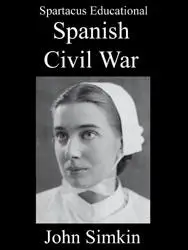Niceto Alcala Zamora
Niceto Alcalá Zamora was born in Spain in 1877. He became a lawyer and later became involved in politics. As a result of his republican views he was jailed in 1930.
Alcalá Zamora took part in the successful revolution that led to Alfonso XIII leaving the country. He became the first president of the new Spanish Republic.
In the elections of February 1936, 34.3 per cent of the vote went to the Popular Front, 33.2 per cent to the conservative parties and the rest to regional and centre parties. This gave the Popular Front 271 seats out of the 448 in the Cortes and enabled them to form the government.
The Popular Front government immediately upset the conservatives by releasing all left-wing political prisoners. The government also introduced agrarian reforms that penalized the landed aristocracy. Other measures included granting Catalonia political and administrative autonomy.
As a result of these measures the wealthy took vast sums of capital out of the country. This created an economic crisis and the value of the peseta declined which damaged trade and tourism. With prices rising workers demanded higher wages. This led to a series of strikes in Spain.
In May 1936 Alcalá Zamora was ousted as president and replaced by the left-wing Manuel Azaña. Soon afterwards Spanish Army officers, including Emilio Mola, Francisco Franco and José Sanjurjo, began plotting to overthrow the Popular Front government. This resulted in the outbreak of the Spanish Civil War on 17th July, 1936.
Alcalá Zamora moved to France. After the invasion of the German Army he went to Argentina. Niceto Alcalá Zamora died in 1949.
Primary Sources
(1) Edward Knoblaugh, Correspondent in Spain (1937)
Azana's government had a difficult time maintaining order. There was a rash of strikes, violence, church burnings and other disorders. Virtually all the news coming out of Spain during my first nine months there dealt with these disorders. Each day would see some new form of violence-some phase of industry tied up or some blood spilled. Rex Smith, then bureau manager of the Associated Press in Madrid, once quite appropriately remarked that it might save us time and cable tolls if we had stereotyped forms made for New York and referred to them by number in indicating repetitions of violence.
The Azana government found itself obliged to use strong measures to curb the disorders. One of these incidents caused Azana's overthrow. Thirteen anarchists, having barricaded themselves in a cafe called Casa de Seis Dedos in the little village of Casas Viejas, fired on the police. The head of the Casas Viejas constabulary asked Madrid for instructions. The Ministry of Interior sent orders to the effect that the place should be cleaned up: "we want neither prisoners nor wounded." The police took these orders literally. Not one of the thirteen escaped alive
The extreme Left took up Casas Viejas as their war cry the thirteen men who had been killed by police bullets became martyrs. Public opinion was so aroused that, following Spanish tradition, it ended in reaction. The Right-Centre coalition of the then unknown newspaperman, Jose Maria Gil Robles, carried the November, 1933, elections in a sweeping upset. Azana was ousted. Gil Robles, by virtue of heading the largest parliamentary minority - the Popular Action group with 112 of the 473 Cortes votes - was first in line to succeed him. But President Niceto Alcala Zamora, although a strong Catholic, did not deem it wise to encourage a Right trend in parliament at that time. Instead, he named Lerroux, the veteran, to the post of Premier.
(2) Luis Bolin, Spain, the Vital Years (1967)
Alcala Zamora was kicked out for dismissing the Cortes unconstitutionally, though he had acted thus - not unwillingly - at the behest of those who ejected him. Azana was elected his successor. No worthier candidate for the Presidency of such a Republic could have been found. His most unprincipled adherent, Casares Quiroga, was appointed Premier and Minister of War. Other posts in the Cabinet were allotted to Republican Left, Republican Union and Catalan Left, willing pawns of the Red extremists, who, for the time being, directed operations from the wings. Revolt broke out in a dozen towns, and outrages were committed daily in Barcelona, Malaga, Saragossa, Granada, Bilbao and Seville. In Madrid, a riot was caused by a preposterous rumour to the effect that ladies who worked for social welfare had distributed poisoned sweets to children. As a reprisal several churches were burnt and three nuns and two other women, one of them of French nationality, were assaulted and almost lynched by an infuriated mob.

